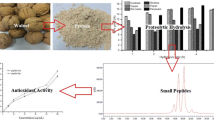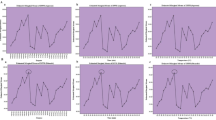Abstract
Walnut (Juglans regia L.) contains approximately 20–25 % protein with abundant essential amino acids. The enzymatic hydrolysate of Persian walnut (Chandler) seed proteins was prepared by incubation with three different proteases, including pancreatic chymotrypsin and trypsin, and a microbial enzyme proteinase K. The hydrolysates were found to possess excellent antioxidant capacities. The peptide fractions scavenged the 2, 2′-anizo-bis-(3-ethylbenzthiazoline-6-sulfonic acid) (ABTS) free radicals and inhibited the activity of reactive oxygen species. Walnut protein hydrolysates were also tested, for the first time, against the viability of human breast (MDA-MB231) and colon (HT-29) cancer cell lines. MTT, [3-(4, 5dimethylthiazolyl)-2,5-diphenyl-tetrazolium bromide], assay was used to assess in vitro cancer cell viability upon treatment with the peptide fractions. The peptide fractions showed cell growth inhibition of 63 ± 1.73 % for breast cancer and 51 ± 1.45 % for colon cancer cells. Thus, a direct correlation between antioxidant and anticancer activities of walnut peptide fractions exists and supports their potential therapeutic benefit.







Similar content being viewed by others
Abbreviations
- ABTS:
-
2, 2′-anizo-bis-(3-ethylbenzthiazoline-6-sulfonic acid)
- ACE:
-
Angiotensin converting enzyme
- CL:
-
Chemiluminescence
- HUVEC:
-
Human umbilical vein endothelial cells
- MTT:
-
3-(4, 5dimethylthiazolyl)-2,5-diphenyl-tetrazolium bromide
- OPA:
-
o-Phthaldialdehyde
- ROS:
-
Reactive oxygen species
- SDS:
-
Sodium dodecyl sulfate
References
Karas M (2007) Anti-free-radical properties of the peptide fractions isolated from string bean by immobilized metal ion affinity chromatography. Protein Pept Lett 14(5):447–454
Valko M, Rhodes C, Moncol J, Izakovic M, Mazur M (2006) Free radicals, metals and antioxidants in oxidative stress-induced cancer. Chem Biol Interact 160(1):1–40
Borek C (2004) Dietary antioxidants and human cancer. Integre Cancer Ther 3(4):333–341
Kitts DD, Weiler K (2003) Bioactive proteins and peptides from food sources. Applications of bioprocesses used in isolation and recovery. Curr Pharm Des 9(16):1309–1323
Gu X, Hou Y-K, Li D, Wang J-Z, Wang F-J (2015) Separation, purification, and identification of angiotensin I–converting enzyme inhibitory peptides from walnut (Juglans regia L.) hydrolyzate. Int J Food Prop 18(2):266–276
Mojica L, de Mejía EG (2015) Characterization and comparison of protein and peptide profiles and their biological activities of improved common bean cultivars (Phaseolus vulgaris L.) from Mexico and Brazil. Plant Foods Hum Nutr 70(2):105–112
Udenigwe CC, Aluko RE (2012) Food protein-derived bioactive peptides: production, processing, and potential health benefits. J Food Sci 77(1):R11–R24
Gu M, Chen H-P, Zhao M-M, Wang X, Yang B, Ren J-Y, Su G-W (2015) Identification of antioxidant peptides released from defatted walnut (Juglans Sigillata Dode) meal proteins with pancreatin. LWT-Food Sci Technol 60(1):213–220
Vinson JA, Cai Y (2012) Nuts, especially walnuts, have both antioxidant quantity and efficacy and exhibit significant potential health benefits. Food Funct 3(2):134–140
Schreinemachers DM, Everson RB (1994) Aspirin use and lung, colon, and breast cancer incidence in a prospective study. Epidemiol 5(2):138–146
Jemal A, Siegel R, Ward E, Hao Y, J X, Murray T, Thun MJ (2008) Cancer statistics, 2008. CA. Cancer J Clin 58(2):71–96
Sze-Tao KWC, Sathe SK (2000) Walnuts (Juglans regia L): proximate composition, protein solubility, protein amino acid composition and protein in vitro digestibility. J Sci Food Agric 80(9):1393–1401
Rahimi M, Ghaffari SM, Salami M, Mousavy SJ, Niasari-Naslaji A, Jahanbani R, Yousefinejad S, Khalesi M, Moosavi-Movahedi AA (2016) ACE-inhibitory and radical scavenging activities of bioactive peptides obtained from camel milk casein hydrolysis with proteinase K. Dairy Sci Technol 489(96):1–11
Church FC, Swaisgood HE, Porter DH, Catignani GL (1983) Spectrophotometric assay using o-phthaldialdehyde for determination of proteolysis in milk and isolated milk proteins. J Dairy Sci 66(6):1219–1227
Re R, Pellegrini N, Proteggente A, Pannala A, Yang M, Rice-Evans C (1999) Antioxidant activity applying an improved ABTS radical cation decolorization assay. Free Radic Biol Med 26(9):1231–1237
Hu Y, Zhang Z, Yang C (2008) A sensitive chemiluminescence method for the determination of H2O2 in exhaled breath condensate. Anal Sci 24(2):201–205
Mosmann T (1983) Rapid colorimetric assay for cellular growth and survival: application to proliferation and cytotoxicity assays. J Immunol Methods 65(1):55–63
Rahman S, Salehin F, Iqbal A (2011) In vitro antioxidant and anticancer activity of young Zingiber officinale against human breast carcinoma cell lines. BMC Complement Altern Med 11(1):76
Zhou K, Sun S, Canning C (2012) Production and functional characterisation of antioxidative hydrolysates from corn protein via enzymatic hydrolysis and ultrafiltration. Food Chem 135(3):1192–1197
Qian Z-J, Jung W-K, Kim S-K (2008) Free radical scavenging activity of a novel antioxidative peptide purified from hydrolysate of bullfrog skin, Rana catesbeiana Shaw. Bioresour Technol 99(6):1690–1698
Kumar NS, Nazeer R, Jaiganesh R (2011) Purification and biochemical characterization of antioxidant peptide from horse mackerel (Magalaspis cordyla) viscera protein. Peptides 32(7):1496–1501
Chen C, Chi Y-J, Zhao M-Y, Lv L (2012) Purification and identification of antioxidant peptides from egg white protein hydrolysate. Amino Acids 43(1):457–466
Tang X, He Z, Dai Y, Xiong YL, Xie M, Chen J (2009) Peptide fractionation and free radical scavenging activity of zein hydrolysate. J Agric Food Chem 58(1):587–593
Amarowicz R, Shahidi F (1997) Antioxidant activity of peptide fractions of capelin protein hydrolysates. Food Chem 58(4):355–359
Hedstrom L, Szilagyi L, Rutter WJ (1992) Converting trypsin to chymotrypsin: the role of surface loops. Science 255(5049):1249–1253
Cai Y, Luo Q, Sun M, Corke H (2004) Antioxidant activity and phenolic compounds of 112 traditional Chinese medicinal plants associated with anticancer. Life Sci 74(17):2157–2184
Dai J, Mumper RJ (2010) Plant phenolics: extraction, analysis and their antioxidant and anticancer properties. Molecules 15(10):7313–7352
Mora-Escobedo R, del Carmen R-RM, Ramón-Gallegos E, Reza-Alemán R (2009) Effect of protein hydrolysates from germinated soybean on cancerous cells of the human cervix: an in vitro study. Plant Foods Hum Nutr 64(4):271–278
Xue Z, Gao J, Zhang Z, Yu W, Wang H, Kou X (2012) Antihyperlipidemic and antitumor effects of chickpea albumin hydrolysate. Plant Foods Hum Nutr 67(4):393–400
Das R, Bhattacharjee C (2013) In Vitro Evaluation of Antioxidant Activity and Radical Scavenging Activity of Sesame Bioactive Peptides. Int J Emerging Technol Adv Eng 3(11):521–527
Acknowledgments
The support of University of Tehran, International Scientific Studies & Collaboration (CISSC)-Ministry of Science, Research and Technology in Iran, Center of Excellence in Biothermodynamics (CEBiotherm), Center of Excellence for Walnut Improvement and Technology of Iran, Iran National Science Foundation (INSF) and Iran National Elites Foundation (INEF) and UNESCO Chair on Interdisciplinary Research in Diabetes, Iran Society of Biophysical Chemistry is gratefully acknowledged. The authors also acknowledge the Headquarter of Science and Technology Development in Medicinal Plants of Iran’s Vice-President for Science and Technology Affairs.
Author information
Authors and Affiliations
Corresponding author
Ethics declarations
Conflict of Interest
The authors declare that there are no conflicts of interest.
Human and Animal Rights
This article does not contain any studies with human or animal subjects.
Rights and permissions
About this article
Cite this article
Jahanbani, R., Ghaffari, S.M., Salami, M. et al. Antioxidant and Anticancer Activities of Walnut (Juglans regia L.) Protein Hydrolysates Using Different Proteases. Plant Foods Hum Nutr 71, 402–409 (2016). https://doi.org/10.1007/s11130-016-0576-z
Published:
Issue Date:
DOI: https://doi.org/10.1007/s11130-016-0576-z




